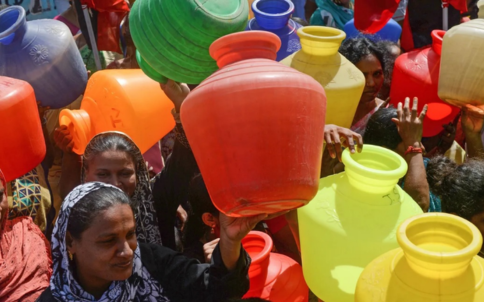Dr.M.Suresh Babu, President, Praja Science Vedika
Tank modernisation should primarily comprise catchment treatment, foreshore plantations, and creation of dead storage for community and livestock use, improvement of supply channels and tank structure, on-farm development works, crop and water management, and provision of community wells wherever feasible. Rehabilitation focus should be on distribution of water based on crop demand and adoption of crop and water management practices through on-farm development. The rehabilitation budget should be allocated in the ratio of 10%, 75%, and 15%, respectively, to institutional development, physical works and maintenance. A one-time investment of 15% for maintenance and management activity is to be allocated from the rehabilitation funds. Addressing the quality of water sources by treating catchment areas. Planting vegetation along the banks of the tank to prevent erosion and improve water quality. Designating a portion of the tank for community and livestock use, ensuring water availability during scarcity.

Irrigation projects worse
Irrigation projects are in a worse situation and might affect the drinking water supply in many parts of AP and TS. Power generation may also be hit as the projects are currently at dead storage level. Major drinking water source of Rayalaseema is the Tungabhadra reservoir, an interstate project under Krishna basin. It has been witnessing worse conditions following poor South-West Monsoon. Krishna and Pennar basins are major water sources for AP. There is an acute shortage of water in their reservoirs even during the early post South- West Monsoon.
Also read: Economic development & gross national happiness models are pertinent
More than 280 villages in the district are facing acute water shortage. In just 15 days from December 30, the number of villages reeling under water crisis shot up to 304 from 280, forcing the Rural Water Services Department to operate more tankers, said groundwater department. Around 3.18 lakh people are being provided water through tankers, as groundwater levels in Anantapur – one of the nine districts in the State identified as water-stressed by the Central government – are depleting day by day.
The groundwater levels in the district plummeted to 16.25 metres below ground, 6.94 metres deeper than what it was during the corresponding period last year. The district has also recorded a rainfall deficit of 38 per cent. According to groundwater officials, the situation has acquired an alarming proportion in 22 mandals in the district. An anticipated depletion of groundwater sources is likely to compound drinking water problem in several municipalities situated in Anantapur district. The Gooty, Rayadurg and Guntakal along with the mandal headquarters are in the midst of an unprecedented water crisis with acute shortage of not just drinking water but also water for daily use.
Groundwater development
Developing full groundwater in the command area by working out the feasible (optimal) number of wells in the tank command area using annual groundwater draft is the primary duty. It is expected that in the tank commands, about 20% increases in the number of wells is possible.
Adopting sluice rotation (opening and closing the sluices in alternate weeks) so that ground water and tank water would be simultaneously (conjunctively) used throughout the crop season.
These options provide a range of strategies for modernizing water tanks, addressing issues such as sedimentation, groundwater recharge, external water sources, and conjunctive use. The choice of option would depend on factors such as local hydrology, water demand, and the specific challenges faced by each tank system.
Also read: Religious nationalism and hegemony can be detrimental
Cascade approach
The focus of rehabilitation in the future will be more on water acquisition, storage and distribution. The cascade approach should be followed in restoring tanks, if the full benefits of harvesting the runoff from a micro watershed and effective groundwater recharge are to be realized. In this entire process of designing tank rehabilitation, capacity building is the core without which sustainability cannot be attained. The first part of the capacity building should focus on strengthening the tank user groups, creating awareness and introducing income generating sources to self-help groups (SHGs). The second part of training can start during the implementation of the rehabilitation works with a due focus on the crop and water management and operation maintenance aspects of tanks. The third part of the training can start focusing on managing tank and tank
The Mahatma Gandhi National Rural Employment Guarantee Scheme (MGNREGS) manpower can be better used in tank improvement works, so that the impact of the MGNREGS labour could be measurable. Integration of tank and ground water system and integration of tanks and social forestry should be carefully inbuilt in the modernisation programme, as they will be highly complementary to improved tank performance. As part of the modernisation process, a database on tanks in the cascade should be generated so as to help to analyse a variety of technical, socio economic, and ecological relationships such as tank storage under varying rainfall regimes, evaporation losses from tank water spread, groundwater storage, recharge rates under different soil and silt conditions, the pattern of water use, and so on. A tank manual should be prepared that could serve as a guidance document to tank management in the long run.
Of the total tanks, about 1% is defunct or absent. About half are already performing as percolation tanks for recharging the groundwater. Therefore, those tanks that are not used for direct irrigation, or tanks that get less than 40% of tank storage in most years can be managed to enhance water storage by converting them into percolation ponds by deepening the storage area and by encouraging farmers to invest in private wells in the command area. Because getting electrical connections is the major constraint in well investment, necessary reforms in providing electrical connections or solar power pumps in rural areas can be considered. Some investment in creating watershed structures such as check dams and percolation ponds in tank intensive regions can be diverted to tank.
Also read: Trust erosion in Academic Publications




